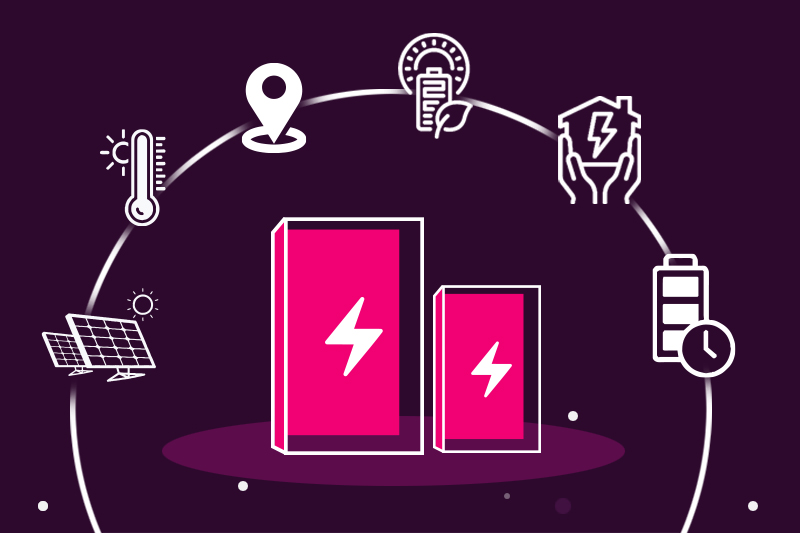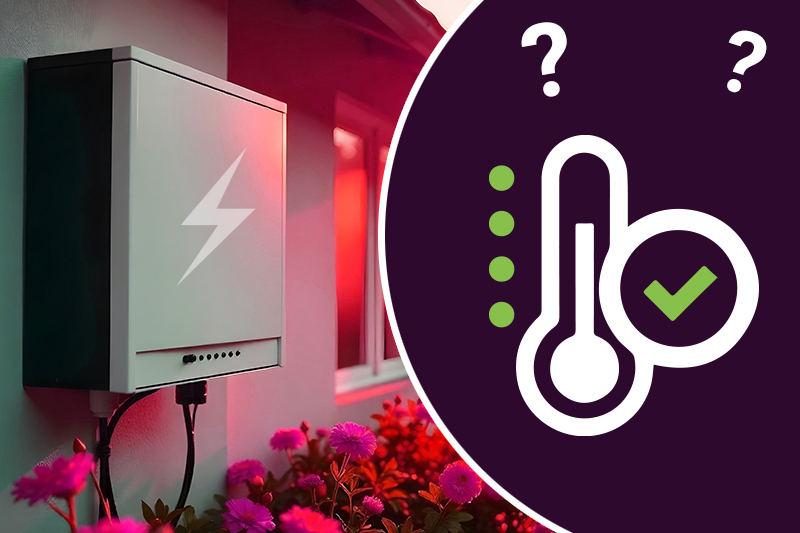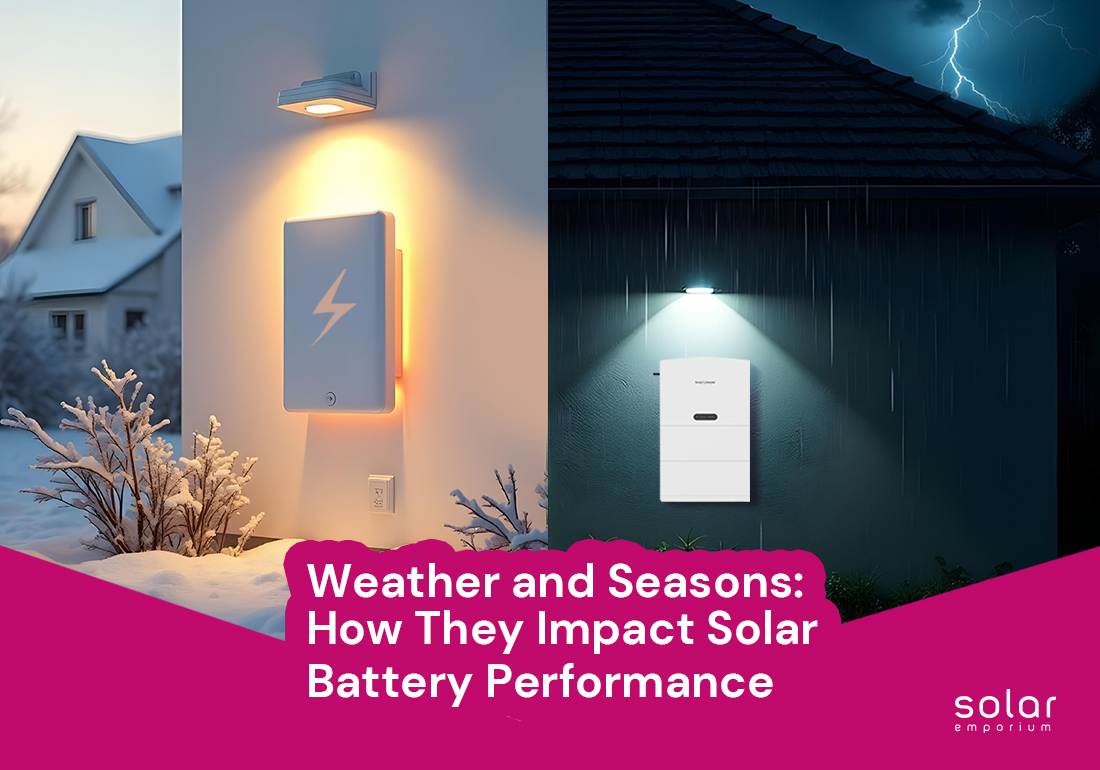Australia, the land of scorching summers and cold, snowy winters, is a place where renewable sources like solar energy could be the key to a sustainable energy future.
But do you know beneath the sun-soaked skies, Australia’s complex interplay of weather and seasons can greatly affect the performance of solar battery systems?
From the intense heat waves pushing solar panels to their limits to the overcast days of winter that leave them lazy, Australian weather and seasons are full of opportunities and challenges.
Well, if you are already thinking about the hurdles and wondering how the change in season will affect your solar system, don’t stress!
In this blog, we’ll uncover how Australia’s weather and seasons impact solar battery performance and what you need to know to optimize your solar energy system.
So, let’s take a closer look!
Power Up with Solar Batteries: Key Insights for Better Energy Management
Before delving into how the weather or seasons affect solar batteries, do you know how solar batteries work? If not, here’s a quick glimpse:
A solar battery is a crucial component of a solar panel system that stores excess energy generated by your solar panels. These batteries act as a backup, ensuring a reliable power source when sunlight isn’t available or solar panel production lowers.
In Australia, batteries are especially important for reducing reliance on the electrical grid, saving on energy bills, and contributing more to a greener environment.
Modern solar batteries typically use lithium-ion technology, which is more efficient, robust, and can hold a charge for significant periods.
They are widely used in portable electronics and electrified transportation in Australia for their fast-charging capabilities, extended lifespan, and lightweight, sleek features.
Weather vs. Solar Batteries | Understanding the Impact on Performance
As the nation embraces solar power, the impact of weather on solar battery’s performance is becoming increasingly crucial.
Understanding these impacts will help you optimize your solar system’s performance year-round in this landscape, where every ray counts. This ensures that you get the most out of your investment regardless of what the weather throws at you.
So, let’s find out how weather affects your solar battery performance!
1. Sunny Days: Maximum Solar Generation, Maximum Storage
On an average sunny day in Australia, solar panels can produce anywhere between 3.5 kWh and 5 kWh (kilowatt-hours).
This means if you have a 5-kW solar system, you can generate roughly 20 to 30 kWh of energy on a sunny day, depending on factors like location, panel angle, and time of year.
Areas with more sunlight, like Queensland, parts of New South Wales, Brisbane, Perth, and Adelaide, tend to generate higher energy output compared to regions with more cloud cover.
This ensures you have enough power to rely on during the grid outages or night times.
Moreover, this ultimately reduces our carbon footprints, eliminating the detrimental effects of global warming caused by heavy reliance on fossil fuels like coal, natural gas, or oils.
Australia’s Solar Efficiency on Sunny Days:
- Peak power generation can reach over 5 kW in good sunlight conditions.
- Solar batteries may charge fully within 4-6 hours of optimal sunlight.
- Homeowners can store enough energy to power appliances and lights through the night.
However, although good sun exposure can boost your energy production, extremely high temperatures above 30°C may reduce the solar battery’s efficiency and lifespan due to overheating.
2. Cloudy Days: Reduced Generation, Impact on Battery Charging
What happens to your solar system on cloudy days? Do they still generate and store power? Can solar energy be used in rainy seasons? You may have heard this question so often nowadays.
Indeed, solar panels produce and store power during cloudy or overcast days, but their output is significantly reduced due to low sunlight hours.
Unlike sunny days, the battery charges at a much slower rate, thus taking more time to reach full capacity. This can affect the amount of energy available to store in the battery, leading to shorter battery life or less energy stored for later use.
Solar Battery Performance on Cloudy Days:
- Solar panels typically produce 20-50% of their usual output.
- Batteries may take longer to charge or may not reach full capacity.
- Households may need to rely more on grid power during these days, increasing energy costs.
This is why it’s better to opt for a large battery storage system, stay connected to the grid, or monitor battery levels and plan your energy consumption accordingly during cloudy or overcast weather.
3. Rainy Weather: Lower Output, Increased Dependency on Grid Power
During wet, cloudy, or stormy periods, your solar panel’s power production rate drops significantly, impacting the charging rate of your solar batteries.
So, what happens to your system when it rains?
Continuous rain and storms can lead to even lower levels of solar generation. So, in addition to solar batteries, you may need to draw more electricity from the grid to meet your needs.
In Australia’s wetter months, residents can integrate solar batteries with the smart grid to maintain a steady energy supply.
This will mitigate the power issues while reducing the overall energy cost for Australians.
Impact of Rain on Solar Battery Efficiency:
- Rain can result in up to 70-80% less solar energy generation.
- Prolonged rainy weather can deplete solar battery reserves faster.
- It may take several days of sun to recharge batteries after rainy periods.

Seasonal Changes: How Australian Seasons Affect Solar Batteries
While weather conditions can cause daily fluctuations in solar energy production, seasons can also affect the overall length and intensity of sunlight. How?
Weather refers to short-term atmospheric conditions like temperature, rain, clouds, and wind that change from day to day or hour to hour, whereas seasons refer to long-term patterns that last for several months.
They are determined by the Earth’s tilt and orbit around the sun. So, do seasons affect the solar battery performance over months? Definitely yes!
1. Summer: High Energy Generation, But Watch Out for Heat!
In Australian cities like Sydney, Melbourne, and Victoria, summer means longer daylight hours of up to 14 hours and plenty of sunshine.
During this time of year, the panel’s power generation increases by up to 30% compared to winter, and your batteries can store more power than usual. This helps you reduce energy bills and be less reliant on the grid.
However, extreme heat can also be a concern for batteries. Without thermal protection, they are more prone to overheating, which lowers their ability to generate energy.
To mitigate this, ensure your solar panels are properly ventilated and cleaned regularly, as dust and debris can increase the temperature and further reduce efficiency.
2. Winter: Shorter Days, Lower Power Generation, More Reliance on Batteries!
There is a common solar battery myth that says they can’t operate in cold climates. The fact is solar batteries typically perform better in the winter season.
Then, how cold weather affect solar battery performance?
Well, even though the weather increases solar efficiency, your battery’s power-holding capabilities decrease due to shorter days and less direct sunlight.
From June to August, solar panels may only produce 40-60% of the energy they generate in the summer, as the sun is at a lower angle in the sky.
Therefore, during winter in regions with less sunlight, such as Tasmania, people install a larger battery storage system or consider a hybrid system with a backup generator to ensure energy security throughout the colder months.
3. Humidity and Rain: Adapt to Low Sunlight!
High humidity levels can create moisture, affecting the batteries’ ability to absorb sunlight effectively.
Prolonged exposure to dampness or moisture can also damage the outer layer of the battery, forming rust, corrosion, and scratches. Ultimately, this degrades the battery quality, leading to lower energy efficiency.
Similarly, rain can create cloud cover that limits the amount of sunlight reaching the panels, reducing their energy generation capacity.
This could lead to slower charging and less energy stored in the battery.
However, nowadays, the innovative future of electricity storage and groundbreaking design ensure that batteries are sealed and weatherproof, so some of them can typically withstand humidity without issue.
7 Other Factors Affecting Solar Batteries Performance in Australia
- Temperature Extremes: Both high and low temperatures can affect solar batteries. Excessive heat can cause batteries to overheat, reducing their lifespan, while extreme cold can make them less efficient in storing energy.
- Location: Your geographic location, like closeness to the coast or altitude, can affect battery performance. Salt from sea air or higher humidity can contribute to corrosion, while higher altitudes might expose panels to harsher weather conditions.
- Battery Age: Solar batteries slowly degrade over time, diminishing their ability to hold charge. The older the battery, the less energy it can store.
- Shading, Panel Orientation, and Tilt: Trees, buildings, or other obstructions block sunlight and impact energy available for storage. Moreover, the angle at which solar panels are installed impacts their ability to capture sunlight. Improper alignment can cause low energy production for storage.
- System Size and Design: The capacity and design of your solar panel and battery determines how much energy can be stored. So, find the best battery storage that fits your needs.
- Maintenance: Regular maintenance of batteries ensures they function optimally. Dirt, dust, and debris on panels can decrease efficiency, while poor battery monitoring can cause them to degrade faster.
- Energy Consumption Patterns: Australians typically use more energy during winter than summer. Higher energy consumption during winter nights or gloomy evenings can strain the battery, leading to faster depletion or inefficient charging.

What’s the Optimal Temperature Range for Solar Batteries?
The optimal temperature range for solar batteries typically ranges between 20°C to 25°C or 68°F to 77°F.
Extreme heat or cold can reduce efficiency and lifespan. This is why some solar batteries, like Tesla Powerwall, are equipped with thermal management systems to maintain optimal temperatures.
How to Mitigate Seasonal or Weather Impacts: Tips to Optimize Solar Battery Performance
After investing in solar batteries, it’s natural that people want to make the most of their solar battery system, especially when considering seasonal and weather variations.
Therefore, in this section, we shared some expert tips that will not only help to maintain the battery’s optimal efficiency throughout the year but also boost your battery performance while addressing seasonal and weather barriers.
- Ensure your solar panels and batteries are clean and debris-free, mainly during summer, with regular maintenance.
- Monitor battery levels and keep track of battery performance, especially during cloudy or rainy weather.
- Adjust your energy usage to ensure you don’t deplete your stored energy.
- Secure your battery storage area by insulating and protecting it from extreme temperatures to minimize the impact of heat or cold on battery efficiency.
- Install a Battery Management System (BMS) for accurate real-time data accumulation and battery inspection.
- Use energy-efficient appliances rely less on battery storage, especially during high-demand times.
- Integrate batteries with smart homes, consider your energy consumption patterns, and upgrade or customize battery size for your seasonal needs.
Preparing Your Solar Battery for Australia's Ever-Changing Weather

Australia’s diverse weather and seasons can indeed impact solar battery performance. However, it is fascinating how proper preparation and system design can optimize solar energy storage.
Whether you’re in sunny Queensland or the cooler regions of Tasmania, there’s a solar battery solution that can meet your needs year-round.
With solar batteries, residents can also reduce their reliance on grid power, save money on energy bills, and contribute more to Australia’s 100% Renewable Energy Transition.
So, choose the right solar battery, maintain it properly, and adjust it according to local climate conditions and seasonal variations to ensure you don’t run out of power when needed.
Want to optimize your solar energy system for Australia’s diverse weather patterns? At Solar Emporium, our expert team is here to help you maximize your solar production and find the best solutions for energy savings in your region.
So, what are you waiting for? Contact us today to win a free solar quote!







